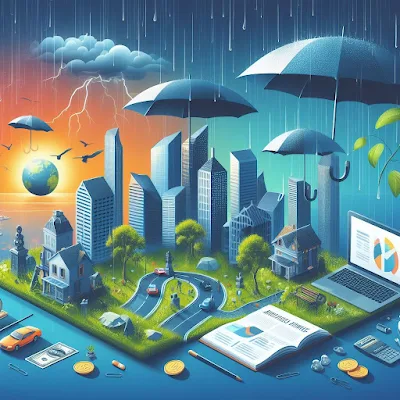Climate Change and Insurance: Adapting to a New Reality
The impacts of climate change are increasingly evident, with rising temperatures, extreme weather events, and shifting environmental patterns affecting communities worldwide. As we confront this new reality, the insurance industry plays a crucial role in helping individuals, businesses, and governments adapt to the challenges posed by climate change.
The Changing Landscape of Risk
Climate change brings about a shift in the landscape of risk. Insurance providers are grappling with the escalating frequency and intensity of natural disasters, such as hurricanes, wildfires, and floods. This changing risk profile necessitates a reevaluation of insurance policies and strategies to effectively mitigate and manage the impacts.
Understanding Climate-Related Risks
For individuals and businesses, understanding climate-related risks is essential. Insurance policies need to address the specific vulnerabilities associated with climate change, considering factors like sea-level rise, extreme temperatures, and the increased likelihood of severe weather events. This understanding forms the basis for robust risk management.
Read More: Insurance for Millennials: Smart Choices for a Secure Future
Property Insurance in the Face of Climate Change
Property insurance is directly impacted by climate change, particularly in regions prone to natural disasters. Homeowners and businesses must assess their property insurance coverage to ensure it adequately addresses the evolving risks. This may involve updating policies to include coverage for climate-related damages and incorporating resilient building practices.
Climate-Resilient Infrastructure Coverage
Governments and municipalities are also reevaluating their infrastructure insurance needs. Investments in climate-resilient infrastructure, such as improved drainage systems and fortified coastal defenses, are becoming imperative. Insurance policies tailored to protect these critical assets help communities bounce back from climate-related disruptions.
Agricultural Insurance: Navigating Uncertain Conditions
Climate change poses significant challenges to agriculture, affecting crop yields and livestock. Agricultural insurance is evolving to provide coverage against unpredictable weather patterns, ensuring that farmers have the financial support needed to recover from crop failures, droughts, or other climate-related setbacks.
Innovative Solutions: Parametric Insurance
Parametric insurance is an innovative solution gaining traction in the face of climate change. Unlike traditional insurance, which reimburses actual losses, parametric insurance pays out a predetermined amount based on specific, measurable parameters, such as wind speed or rainfall levels. This provides quicker financial assistance in the aftermath of a climate-related event.
Insuring Against Business Interruption
Climate change can lead to business interruptions due to weather-related events. Business interruption insurance is crucial for enterprises facing disruptions in their operations. It helps cover lost income, ongoing expenses, and the costs of relocating or rebuilding after a climate-induced incident.
Public-Private Partnerships: Strengthening Resilience
Public-private partnerships are emerging as key players in enhancing climate resilience. Governments and insurance providers collaborate to develop risk-sharing mechanisms and incentivize investments in adaptation measures. These partnerships contribute to building more resilient communities in the face of climate change.
Emergence of Climate Liability Insurance
As the legal landscape evolves, climate liability insurance is gaining attention. This type of insurance helps businesses manage the financial risks associated with potential climate-related lawsuits. It provides coverage for legal defense costs and potential liability judgments stemming from allegations of contributing to climate change.
Encouraging Sustainable Practices
Insurance companies are increasingly incorporating sustainability into their practices. They incentivize policyholders to adopt eco-friendly measures by offering discounts for sustainable building practices, energy-efficient technologies, and environmentally responsible behaviors. This aligns insurance with broader efforts to combat climate change.
Enhanced Data and Technology Integration
Data and technology play a pivotal role in climate change adaptation. Insurers are leveraging advanced analytics, satellite imagery, and climate modeling to assess risks more accurately. This data-driven approach enables them to tailor insurance products to the specific climate-related challenges faced by different regions.
Encouraging Individual Climate Action
Insurance providers are not only adapting their offerings but also encouraging individual climate action. They promote initiatives that reduce carbon footprints, such as usage-based insurance for eco-friendly driving or discounts for homes with energy-efficient features. This synergy between insurance and sustainability reinforces a collective commitment to mitigating climate change.
Global Cooperation in Risk Management
Climate change is a global challenge that requires coordinated efforts. Insurance providers are engaging in global cooperation to share expertise, data, and innovative solutions for effective risk management. This collaborative approach enhances the industry's ability to address the transboundary nature of climate-related risks.
Educating Consumers: Climate-Smart Insurance Choices
Consumer education is paramount in the context of climate-smart insurance choices. Insurers are investing in initiatives to raise awareness about the climate-related risks covered by policies. Informed consumers can make choices that align with their values and contribute to building a more resilient society.
Regulatory Frameworks: Adapting to Climate Realities
Regulatory bodies are adapting to the climate realities by incorporating climate-related considerations into insurance oversight. This includes reviewing solvency requirements, disclosure standards, and stress testing to ensure that insurers are adequately prepared for the financial impacts of climate change.
Insurance for Climate-Induced Migration
As climate change contributes to displacement, insurance for climate-induced migration becomes an essential consideration. Policies addressing the unique risks faced by climate refugees, such as loss of property and livelihood, are crucial for providing financial assistance and support during relocation.
The Role of Microinsurance in Vulnerable Communities
Vulnerable communities often bear the brunt of climate change impacts. Microinsurance, designed for low-income individuals and small businesses, plays a crucial role in providing affordable coverage. These tailored policies offer a safety net for those who may be disproportionately affected by climate-related events.
Insurance as a Catalyst for Resilience
In essence, insurance is becoming a catalyst for resilience in the face of climate change. The industry's adaptation efforts, coupled with individual and collective actions, contribute to a more sustainable and secure future. As we navigate this new reality, insurance emerges not just as a financial tool but as a crucial component of global climate resilience.

